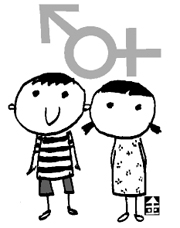X and Y

But on the whole, we have seen a preference for male children in all ages and countries, to the extent that the Greek philosopher Aristotle recommended, “If you want to have a male child, put your bed in a south-north position.” The Greek philosopher Anaxagoras believed that if a man lay on his right side during intercourse, a boy would be conceived.
The sex of the baby depends on whether the sperm fertilizing the egg contains an X or a Y chromosome. If the Y-carrying sperm gets to the egg first, the baby will be a boy; if the first sperm has an X, you get a girl.
But some experts insist that the egg chooses a sperm containing an X or Y chromosome under specific conditions. The general ratio of female to male births is 100 to 105. This can be explained by the fact that male birth rates see a huge increase during certain periods. A study on when we have a better chance of conceiving a boy is still under way.
In 2005, experts from the London School of Economics showed that accountants, mechanics, mathematicians and physicians have a higher chance of conceiving a son, while people engaged in jobs that involve taking care of people, such as nursing or education, are likely to give birth to a daughter.
Other studies revealed that 51.5 percent of those couples who lived together during the pregnancy gave birth to a son, while only 49.9 percent of those who lived separately had a boy. In addition, researchers in New Zealand insisted that outgoing females conceived more boys than introverted, passive ones.
However, we have seen a consistent decline in male birth rates in developed countries in the past four decades.
A variety of stress conditions and increased pollution hamper the vitality of the sperm that carry the Y chromosome, thus reducing male birth rates.
Scientists from Columbia University reported that male children have a higher mortality rate than females when a young unmarried woman gives birth to a child.
The Ministry for Health, Welfare and Family Affairs has recently unveiled a plan to revise a medical law by the end of this year, and allow doctors to reveal to parents the sex of unborn babies that are 28 weeks or more along. This move could be viewed as an important step in satisfying parents’ right to know, but people worry about an unexpected increase in illegal abortions.
It took 25 years for Korean society to achieve a normal sex ratio at birth. We must do our best to keep from regressing back into the past.
The writer is a JoongAng Ilbo reporter who specializes in environmental issues.
By Kang Chan-soo [envirepo@joongang.co.kr]










with the Korea JoongAng Daily
To write comments, please log in to one of the accounts.
Standards Board Policy (0/250자)